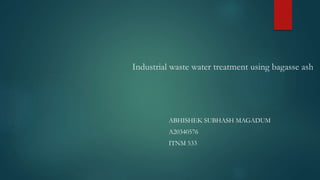
Presentation 2 1
- 1. Industrial waste water treatment using bagasse ash ABHISHEK SUBHASH MAGADUM A20340576 ITNM 533
- 2. Introduction Water Industrial wastewater treatment Uses of dyes in various industries such as – Textile, food and beverage, paper and pulp, cosmetics, rubber, plastics etc. Dyes are used in a number of industries such as textile, paper and pulp, food and beverage, rubber, plastics and cosmetics. The waste water from these industries is high in organic content and very high level of COD.
- 3. Technologies for color removal Biological methods- Fungal decolorization, microbial degradation, bioremediation system. These methods require large land area and microorganisms are constrained by sensitivity toward diurnal variation and toxicity of chemicals. Chemical methods- Chemical methods include coagulation or flocculation combined with flotation and filtration, precipitation-flocculation with Fe(II)/Ca(OH)2, electro flotation, electro kinetic coagulation, conventional oxidation methods by oxidizing agents (ozone), irradiation or electrochemical processes. These chemical techniques are often expensive, and although the dyes are removed, accumulation of concentrated sludge creates a disposal problem.
- 4. There is also the possibility that a secondary pollution problem will arise because of excessive chemical use. Although these methods are efficient for the treatment of waters contaminated with pollutants, they are very costly and commercially unattractive. The high electrical energy demand and the consumption of chemical reagents are common problems. Physical methods : Different physical methods are also widely used, such as membrane – filtration processes (nanofiltration, reverse osmosis, electro dialysis) and adsorption techniques. The major disadvantages of the membrane processes is that they a limited lifetime before membrane fouling occurs and the cost of periodic replacement must thus be included in any analysis of their economic viability. In accordance with the very abundant literature data, liquid-phase adsorption is one of the most popular methods for the removal of pollutants from wastewater since proper design of the adsorption process will produce a high-quality treated effluent.
- 5. Adsorption Adsorption is defined as selective concentration or retention of one or more components of a mixture on a surface. Physisorption Chemisorption Adsorption Isotherms Freundlich isotherm is used for the Studies conducted in this project.
- 6. Adsorbent Sugar cane bagasse is a byproduct in the sugar industry. It is a fibrous material containing Cellulose 45–55% Hemicelluloses 20–25% Lignin 18–24% Ash 1–4% Waxes <1% Bagasse is an extremely inhomogeneous material comprising around 30-40% of "pith" fiber, which is derived from the core of the plant and is mainly parenchyma material, and "bast", "rind", or "stem" fiber, which comprises the balance and is largely derived from sclerenchyma material Bagasse has to treated with Sulphuric acid and formalin, It is then dried and burned to form Activated carbon.
- 7. Activated Carbon From bagasse
- 8. Adsorbate Acid orange-II is an industrial dye with molecular formula C16H11N2NaO4S. It is an acid dye originated from Tianjin, China. CAS NO. - 633-96-5 It has numerous applications; it is widely used in Dyestuffs, Leather Dyestuffs, Paper Dyestuffs and Textile Dyestuffs etc. Dyes based upon their composition can be extremely harmful if ingested and are generally skin irritants if present in large concentrations. These dyes result in high level of COD levels and can be very harmful to the aquatic life present in the region or water body. These dyes are extremely difficult to extract and often expensive.
- 9. Calibration chart using spectrophotometer Optimum pH studies, adsorption vs pH curve
- 10. Concentration Studies. Dosage Studies
- 11. Freundlich Isotherm, Ln Xe vs Ln Ce.
- 12. Economic Analysis Activated carbon used in various industries such as industrial waste water treatment, cosmetics, odor removal, air filtration etc. The average market prices were analyzed as shown in the table, Activated Carbon Activated carbon from bagasse Cost per pound $1.2 $0.38 Regeneration cost $0.35 $0.35 Raw material variable $15 per ton Cost for a small plant, Annually $360,000 $105,000
- 13. SWOT analysis Strengths- More efficient, three times cheaper than conventional AC, wide range of applications, tailor made for textile and paper industry waste water treatment. Weakness- Availability of sugar cane bagasse, not applicable to every waste water treatment facility, needs further column studies for commercialization. Opportunities- Very economical for countries producing sugar cane like brazil, India, USA, Cuba etc, More stringent laws on effluent water will increase the market, can be easily modified for other applications. Weakness- Variation in international market for raw material and chemicals can have big impact, Competition from similar products, new technologies such as membrane filtration and fungal decolorization may become economically viable in future.
- 14. Conclusion- Sugar cane bagasse ash, an agricultural by-product, acts as an effective adsorbent for the removal of dyes from aqueous solution. It has shown 89% removal efficiency of acid orange-II for batch studies. The cost analysis shows a major advantage over traditional activated carbon. The availability of bagasse is a major factor in the cost determination. Compared to the general activated carbon that we get in market, this product is highly efficient in the removal of dyes, pigments and odors. Activated carbon has wide ranging applications and hence this can be used wherever activated carbon is used. More studies are necessary to support the product as we still need column studies, handling capacity, regeneration time and cycle. Companies and industries associated with waste water treatment, sugar production, specialty chemicals, textile industries, paper and pulp industry, food and beverage industries etc should sponsor this project and move towards its commercialization.
- 15. Thank you